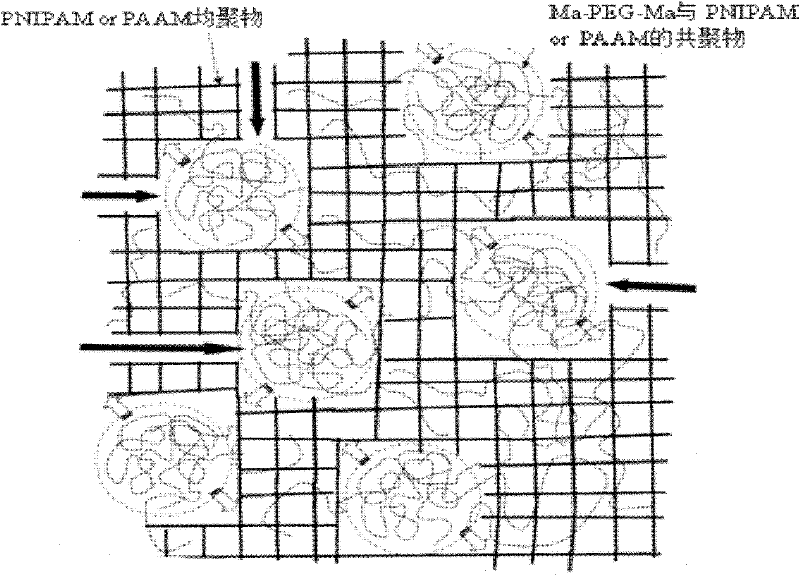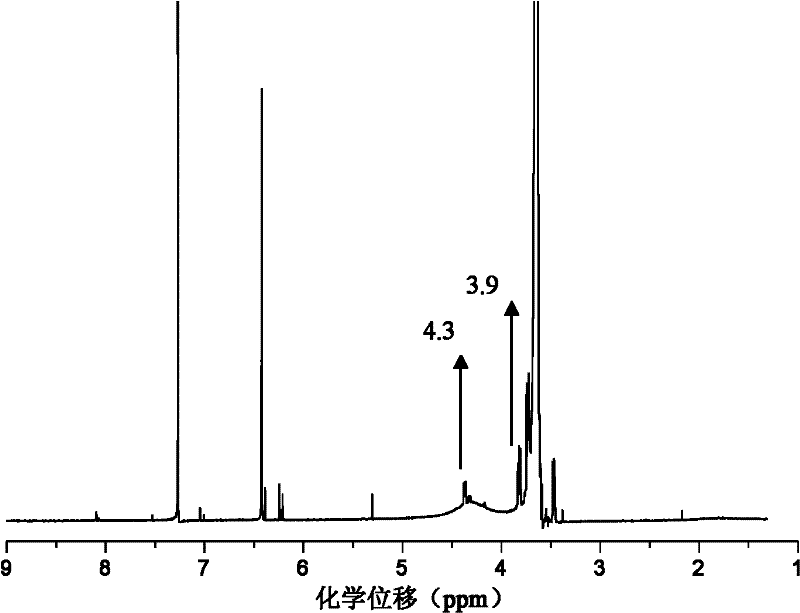Double network polymer hydrogel and preparation method thereof
A polymer and hydrogel technology, applied in the field of biomedical materials, can solve the problems of unreported research, fragile, unsatisfactory response rate, etc., and achieve the effect of wide application prospects.
- Summary
- Abstract
- Description
- Claims
- Application Information
AI Technical Summary
Problems solved by technology
Method used
Image
Examples
Embodiment 1
[0046] Step 1. After drying and removing water, 2g polyethylene glycol (PEG) with a molecular weight of 200, 1.86g maleic anhydride, and 5mL toluene were added to the reaction vessel, sealed, evacuated, replaced with nitrogen, and stirred at 65℃ After 10 hours, the reaction was stopped, and the toluene in the reaction vessel was evaporated to dryness by rotary evaporation to obtain polyethylene glycol maleic anhydride diester.
[0047] Step 2. Dissolve polyethylene glycol maleic anhydride diester in 10-20 mL of dichloromethane, then precipitate in 100-200 mL n-hexane, and obtain pure polyethylene glycol maleic anhydride diester after suction filtration;
[0048] Step 3. Mix 0.24g product A with 0.083g N-isopropylacrylamide monomer after drying and purification, 0.067g potassium persulfate, 0.0616g N,N-methylenebisacrylamide (BIS), add 3 ~4mL of double distilled water, mixed and stirred uniformly, heated in the reaction vessel to 75°C and reacted for 2h to obtain DN polymer gel.
[0...
Embodiment 2
[0054] Step 1. After drying and removing water, 4g polyethylene glycol (PEG) with molecular weight of 400, 2.41g maleic anhydride and 8mL toluene were added to the reaction vessel, sealed, evacuated, replaced by nitrogen, and stirred at 65℃ After 10 hours, the reaction was stopped, and the solvent in the reaction vessel was evaporated to dryness by rotary evaporation to obtain polyethylene glycol maleic anhydride diester.
[0055] Step 2. Dissolve polyethylene glycol maleic anhydride diester in 12 mL of dichloromethane, and then precipitate in 120 mL of anhydrous ether, and obtain product A after suction filtration;
[0056] Step 3. Mix 0.45g product A with 0.148g acrylamide monomer after drying and purification, add 0.026g 2,2-dimethoxy-2-phenylacetophenone (DMPA), add 3.5mL double distilled water In the process, mix and stir uniformly, move to a mold, and irradiate under 500W ultraviolet light for 20 minutes to obtain a dual-network polymer hydrogel.
[0057] Step 4. Then cut the ...
Embodiment 3
[0060] Step 1. After drying and removing water, 8g polyethylene glycol (PEG) with a molecular weight of 800, 2.88g maleic anhydride, and 14mL toluene were added to the reaction vessel, sealed, evacuated, replaced by nitrogen, and stirred at 70℃ After 15 hours, the reaction was stopped, the organic solvent in the reaction vessel was evaporated to dryness, and polyethylene glycol maleic anhydride diester was obtained.
[0061] Step 2. Dissolve polyethylene glycol maleic anhydride diester in 16 mL of dichloromethane, then precipitate in 160 mL of n-hexane, and obtain product A after suction filtration.
[0062] Step 3. Mix 0.79g product A with 0.159g N-isopropylacrylamide monomer after drying and purification, 0.089g ammonium persulfate, 0.0674g ethylene glycol dimethacrylate (EGDMA), and add 3.8mL dimethacrylate Distilled water twice, mixed and stirred uniformly, heated in a reaction vessel to 75°C for 2 hours to obtain DN polymer gel.
[0063] Step 4. Then cut the dual network polyme...
PUM
| Property | Measurement | Unit |
|---|---|---|
| compressive strength | aaaaa | aaaaa |
| compressive strength | aaaaa | aaaaa |
| compressive strength | aaaaa | aaaaa |
Abstract
Description
Claims
Application Information
 Login to View More
Login to View More - R&D
- Intellectual Property
- Life Sciences
- Materials
- Tech Scout
- Unparalleled Data Quality
- Higher Quality Content
- 60% Fewer Hallucinations
Browse by: Latest US Patents, China's latest patents, Technical Efficacy Thesaurus, Application Domain, Technology Topic, Popular Technical Reports.
© 2025 PatSnap. All rights reserved.Legal|Privacy policy|Modern Slavery Act Transparency Statement|Sitemap|About US| Contact US: help@patsnap.com



